Huw Jones, Malcolm Reid, Morgan Specht
Fault Rifts is a small and obscure series of passages in Ogof Draenen. It was first entered when myself and Peter Bolt of Morgannwg C C, climbed in to it from Fault Chambers, soon after the initial big breakthrough in the cave, in 1994. We found that the series had another connection into Fault Chambers, plus a connection to another passage that we later realised was Going Square. I explored the series again, a couple of weeks later, with Huw Durban. We did the scarily exposed climb up out of Fault Chambers again and followed a southerly trending passage down a loose climb, through a bedding plane and to the base of a narrow rift. The rift is a bit like the notorious entrance rift in Llanelly Quarry Pot but much, much more difficult! At the top we found a loose passage trending South but choking after a couple of hundred metres. I named this Headache Passage, as that’s what Huw D was suffering with! Unfortunately his headache quickly developed into a full blown migraine and we had to start out, leaving a couple of crawls heading off to the West. Back down the rift and up the loose climb, I spotted a little rift on the left and pulled out a few boulders to find a large shaft with a fair bit of water falling, which obscured the view up and down. We then made our way out via Going Square.
Later I dropped the wet shaft with some MCC people but at the bottom, the water flowed into a passage much too small to follow. I named the shaft Vertical Reality. Sometime later, while talking to the people from Chelsea S S who were doing the Grade 5 survey, they asked about the way into Fault Rifts from Going Square. “Is it up the climb, across the awkward traverse and through the little hole?” “That’s the one.” I replied. Sometime later again, I bought an interim copy of the survey and noticed that Fault Rifts was on there. I also noticed that the surveyors had obviously been through the crawls Huw D and I had left in Headache passage. I’d forgotten all about them! It was a bit difficult to work out from the survey but it looked as if at least one of the crawls linked into a passage running parallel with Headache. To the North it ended at the other side of the wet shaft we’d dropped previously – Vertical Reality (we had noticed a window, high up on the other side). It also headed South, well beyond the limit of Headache Passage, to end at another shaft. It was the way the pitch lengths were marked that got my interest. Where as all the other pitches on the survey were marked with definite and obviously accurately measured lengths, such as 14m or 22m etc., here the shafts were marked as being 15m+ (Vertical Reality), 20m+ (same shaft but from the window at the northern end of the parallel passage) and 30m+ for the shaft at the southern end of the parallel passage. They looked like estimated depths so it was probable that the surveyors hadn’t been down the pitches and maybe no-one had been down the 30m+ pitch. 30m would also make it the biggest pitch in the cave and I thought I just had to check it out. I never did though and then I stopped caving for ten years!
When I’d started caving again and rejoined my caving clubs, I had a few things in mind that I wanted to check out, including some in Draenen. I was chatting to Malcolm Reid about Draenen at one of the BCC meetings and he mentioned the 30m+ shaft in Fault Rifts, which was one of the things I wanted to look at! He also thought there was a chance that no-one had been down there, despite it being nearly 20 years since it was discovered. We soon had Huw Durban and Morgan Specht interested too and started to make plans to drop the 30m shaft.
In the end Huw D. couldn’t make it so it was just myself, Malc and Morgan. We arranged to meet at a car park in Blaenafon at 8am on a Sunday morning, where we could leave two of the cars and travel up to Pwll Du in just one, hoping to be underground by 9am. The early start was because it was going to be a long trip and also Morgan was hoping to spend some time with his better half in the evening. Unfortunately Malc was a little late and then realised that he’d forgotten to bring the Draenen key with him! We put all our stuff into Malc’s car, went to his to pick up the key, then drove straight up to Pwll Du.
We headed into Draenen with a heavy tackle bag each and I remember saying to Morgan that it was going to take about two hours to reach the pitch but that the route was a bit involved. We stopped off in Indiana Highway to pick up the 40m rope we’d stashed there after the trip where we dropped the big pitch that you normally traverse over but where we’d failed to get down the second pitch (see the previous trip report). Two hours after entering the cave and we were just heading into the start of the ‘involved’ bit as we turned down Going Square! Going Square is mainly walking but interspersed with a few tight crawly bits. At a corner we headed into the connecting passages to Fault Rifts, which start with an easy going crawl leading to a slightly larger passage. At a complex little junction we took a short, flat out crawl on the right, which includes a couple of tightish bits. This led into a walking passage, where a hole at the back of an alcove on the left is the way on. The hole is at roof level, about 3m up and can’t be reached directly. We crawled through a hole at the base of a wall which separates the alcove from the main passage and climbed onto the top of the wall. Then we had to traverse over to the hole which is awkward because the tiny footholds are only about a metre below the ceiling, which means the traverse has to be done whilst bent double. I went first, then hauled the bags up. Another climb followed, higher but more straightforward. As I touched the first handhold, it promptly fell to the floor! With one person at the top and one half way, the bags were passed up the climb. At the top, we entered a chamber at the head of the direct climb up from Fault Chambers, the original way into Fault Rifts. Turning right, we made our way along the bouldery passage, taking a quick detour to have look at Vertical Reality, to the loose climb down near the end. Something fell off this climb every single time someone climbed up or down it! At the bottom, a short crawl through a bedding led to the climb up to Headache Passage.
I remembered how difficult the rift had been, when me and Huw D climbed it for the first (and for us only) time, all those years ago and there were a few doubts in my mind as to whether or not I could still climb it. Below where you climb up, the rift opens up and drops away so there’s the worry that if you slip, you’ll slide passed the bedding plane, into the wide bit and fall right to the bottom. Not wanting to think about it too much, I made a start. I stepped off the bedding floor and wedged myself in the rift, that bit was easy, making upward progress was a different matter. This part of the rift is very narrow and there is not much in the way of hand or foot holds other than a few, not very pronounced, bulges. Thrutching for all I was worth, I started to make agonisingly slow progress, sometimes slipping back a little, loosing hard fought ground. I was already breathing very hard and my heart was pounding so I decided I needed to go for it as hard and fast as possible, to get up before I got too tired. After about three metres of this frantic effort, the rift became less tight and the holds a bit more defined, although well spaced out. At least I could rest a little and was now fairly certain I could get to the top. It still wasn’t easy but I arrived at the top, at the opposite end of the rift to where I needed to be and traversed easily over to the other side. I’d trailed the end of one of the ropes behind me as I climbed and used this to haul up the bags.
Morgan tried next. He got into the rift but just couldn’t make any progress. He’s taller than me and I think he just couldn’t raise his long legs enough to be of any use in pushing upwards. He soon got tired and had to slip back down into the bedding. Morgan and Malcolm were both concerned about slipping and falling to the bottom so, finding a large, solid thread belay, I dropped a lifeline down. Malc tried next but made little more progress than Morgan had, until Morgan wedged himself in underneath and let Malcolm stand on his shoulders! Malc managed to push upwards a little and then started thrutching diagonally up the rift, towards me. This meant that rather than going straight up to reach the wider bit, it was tight all the way but he made it, passing under a boulder that was wedged in the rift. He went to have a look along the passage while Morgan had another go. I tried hauling on the lifeline but that didn’t help so I locked it off so Morgan could pull on it. That didn’t work either as we were at opposite ends of the rift so he was getting pulled sideways rather than upwards. As Malc returned, Morgan had to give up. We had now been underground for about 3.5 hours, so much for my estimate of 2 hours to get to the pitch!
Still keen to get down the pitch, I asked Morgan if he would be prepared to wait while myself and Malc at least made a start on rigging the pitch. If there were no useful natural belays, then we would have to install a number of bolts by hand and that would take 20-30 minutes per bolt! Morgan agreed and we repacked the rigging gear from Morgan’s bag into the other two. We lowered Morgan’s bag back down to him and luckily he had brought along some extra clothing that would help him keep warm.
Malc and myself started off along Headache, each lumping a ridiculously heavy and over stuffed tackle bag. First of all there was an extremely loose boulder slope / choke to negotiate. In fact, the whole of Headache Passage is very loose, being developed along a fualt. I’d forgotten just how loose! We made our way along and soon found ourselves at the choked/calcited end of the passage. We’d completely missed the crawls! We backtracked and found the first crawl that looked like it should connect with the parallel passage shown on the survey. This was the larger of the two but quickly choked at a narrower section. We backtracked some more and soon found the other crawl. This was a lot smaller, wide but very low and with a few small stals dotted through. We’d now been going for about four hours and still hadn’t reached the pitch. It looked like it would be a very difficult job to get the big bags through the low crawl and even if we got the gear to the pitch, we wouldn’t then have time to do anything useful. We also didn’t want Morgan to be waiting alone for too long. It was time to make a decision. I suggested leaving the bags but still going to the pitch, that way something useful would come out of the trip. We could quickly reconnoitre the parallel passage and could confirm whether or not there were any signs of the pitch having been rigged in the past, such as bolts or even just tell-tale marks.
Malc agreed and so I led on through the crawl, now into new passage for me and thankful to be caving without the bag for a while. The crawl was low and got lower, to the point where you had to breath out to move forward. The crawl rounded a very sharp bend and ended at the base of a damp choke. There was a route upwards through it and I wondered if it had had to be cleared the first time someone had come through here. At the top was a small, short passage and then a little porthole through into a much larger space, the parallel passage at last. We turned left, South, and the passage immediately shrank to a hands and knees crawl. After a climb down into a continuation of the crawl, the passage enlarged to a taller rift about a metre wide. A short passage on the left was obviously the other end of the larger but choked crawl between Headache and the parallel passage. After a short traverse we arrived at a climb down with a large, deep, straight rift heading off in front. I climbed down and considered if it was best to traverse across from where I was or drop down again to the base of the rift. Malc decided he was going to stay at the top of the last climb and wait for me there. I decided to drop down and moved forward along the bottom of the rift but it was tight and I was dislodging crystals from the walls as I went so I regretted coming this way. At the far end, the rift was wider but also had a big pile of boulders almost filling it. There appeared to be two possible ways on, either underneath the boulders or a tricky looking climb up and over the top. I could now hear falling water, I presumed from the pitch itself. The sound of the water was loudest from above and so I decided to go that way. The rift was wider here and the climb a little daunting, particularly as I was on my own and it certainly got the adrenaline flowing as I really didn’t want to take a fall here! At the top, an easy passage, with the boulders on the left and a solid right wall, quickly brought me out to the pitch head.
Glad to finally be at the pitch, I started to have a good look around. Ahead was a decent sized black space with water falling on the right hand side. From where I was, I couldn’t see the top or bottom of the shaft but turning my lamp up to full power, I could just make out the far side, where it seemed to narrow back down into a rift. It was impossible to tell if there was a way on but a dark area part way up held out hope. I carefully checked out the walls and boulders around me but I couldn’t see any marks that showed that someone had been here before. Someone had of course, as the place was on the survey but whoever it was hadn’t left any signs of their presence. There were certainly no bolts in the walls and no scuff marks from ropes or slings. To get a better look down the pitch I needed to move forward but I couldn’t be certain if the boulders in the floor were solid and the walls were too far apart to bridge. Memories came back of doing something similar at the Vertical Reality shaft nearby, where I’d stepped onto a large slab lying on a slope dropping to the pitch head and it had started sliding towards the pitch itself! I’d probably only ‘surfed’ the slab for a fraction of a second, before jumping off and doing a starfish impression between the walls but it had seemed like much longer! I carefully stepped down onto a flat-topped boulder near the pitch head, very slowly transferring my weight onto it. It held firm and as I put my foot down a thin mud crust on the top split apart. I was obviously the first person to step on this boulder and I didn’t think anyone could have dropped the pitch without having stood on it. I was now completely sure the pitch had never been descended. I dropped a couple of stones down the pitch to try to get an idea of it’s depth. I didn’t time them properly or do any calculations but it seemed to me that the shaft was about the same as others in the cave I’d dropped stones down, most of them around 20 – 22m so less than the 30m+ shown on the survey.
It was time to head out. There was a hole and a slope down below the boulders wedged in the passage. I decided to check it out, to see if I could bypass the climb back down, on the other side of the boulders. The slope was steep and loose looking and as I carefully took my first step, a boulder slid away and caused a chain reaction, knocking down a lot more below it as it rolled. It made a terrific racket and Malc said later that he was a bit concerned about what had happened. I reasoned that the slope was now a lot more stable and tried it, with nothing much else moving. This brought me back to the start of the long, straight rift and this time, rather than squeeze along at the bottom, I climbed up a little and traversed, which turned out to be relatively easy. As I got closer to him, Malc started out in front of me. Back through the crawl and we were soon in the larger part of the parallel passage, where the route out to Headache was in the right hand wall. We continued North along the passage, to were it ended, overlooking the Vertical Reality shaft, then backtracked to take a look at a side passage that headed towards Headache Passage. This choked, probably near the loose choke at the start of Headache. The only option was back through the low crawl, after which we picked up the bags and made our way back along Headache, to the top of the tight rift climb. There was no sign of Morgan so we dropped down, crawled through the bedding and scrambled up the loose climb, where more things fell off! We were reunited with Morgan in the chamber at the head of the climb up from Fault Chambers. He had been waiting on his own for an hour and a half! We discussed leaving the ropes here for a return but Malc didn’t think it was a good idea to leave them in such a remote place, just in case we didn’t come back, plus he thought we might take another look down the pitch in Indiana Highway first. We gave Morgan some of the kit to carry and made our way out via Going Square, stashing the 40m rope in Indiana Highway again. I, for one, was pretty knackered by the time we got out! It had been a long, hard trip and we’d failed to get down the pitch but at least we now had better knowledge of the route and knew that no one had been down the pitch before. We were going to have to go back. Unfortunately for Morgan, he was too late for his evening out, which I don’t think made him very popular!

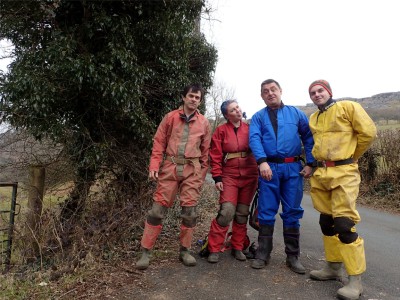

















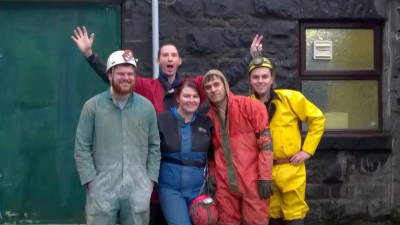
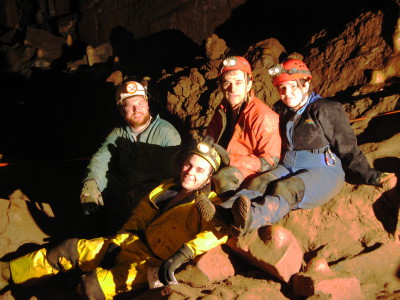
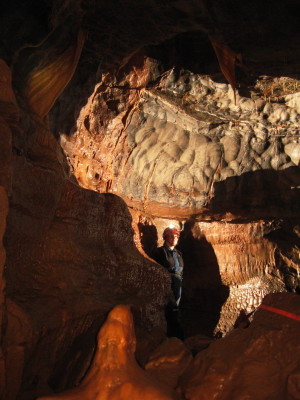
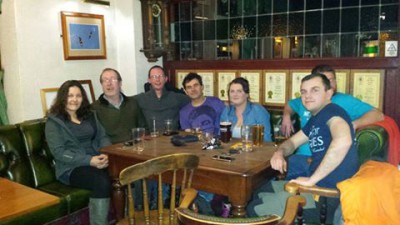

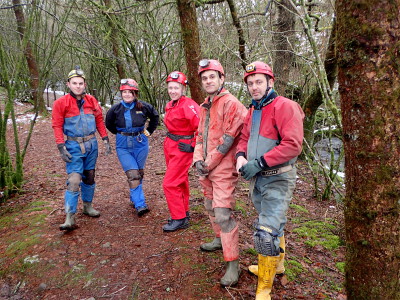












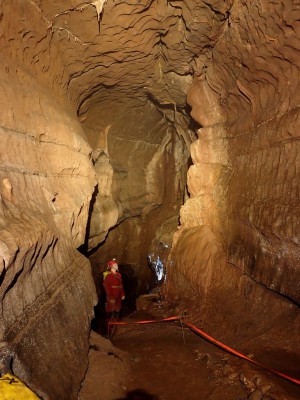






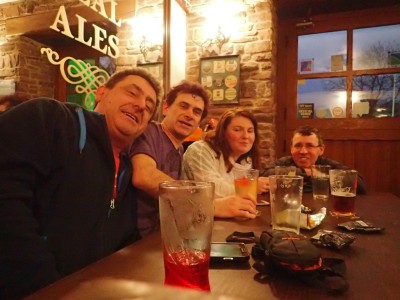
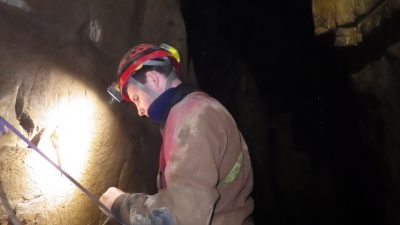
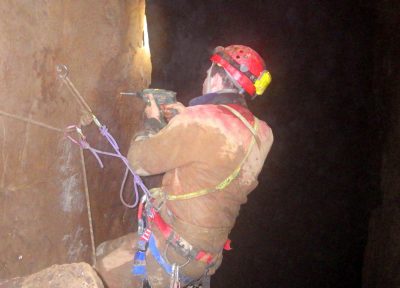
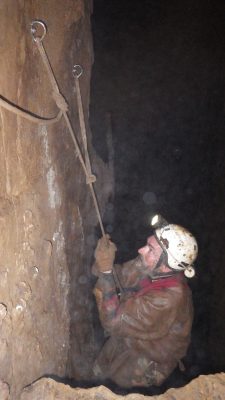















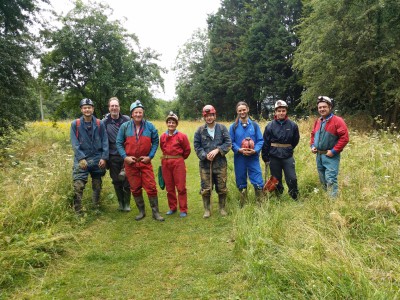
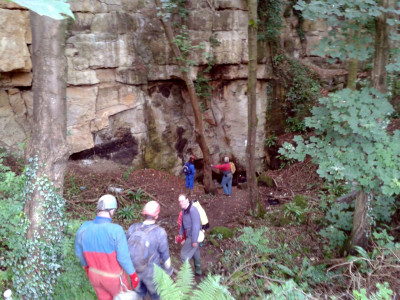




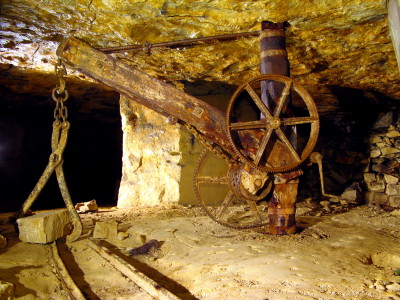
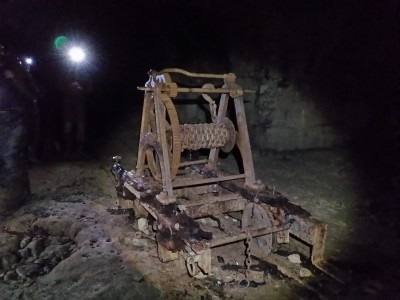
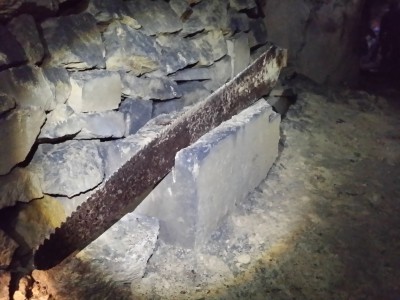
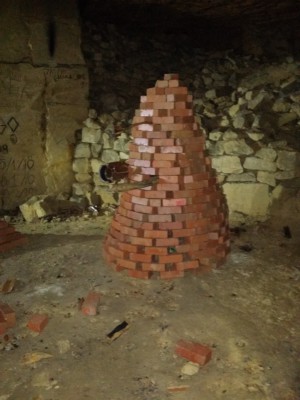


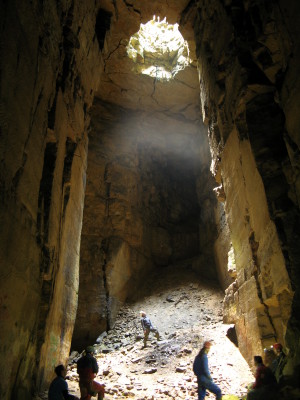
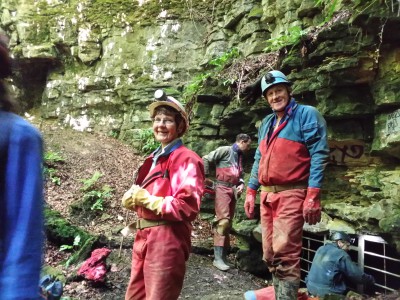
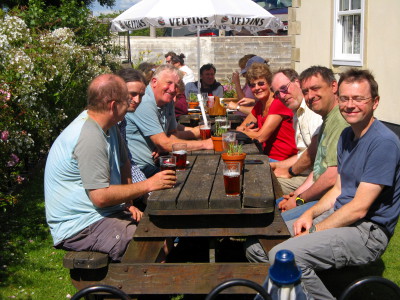
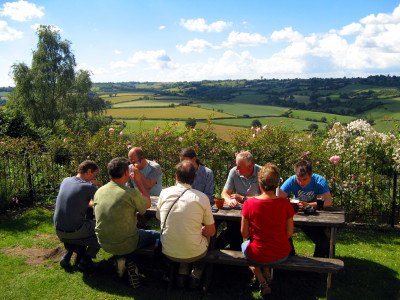
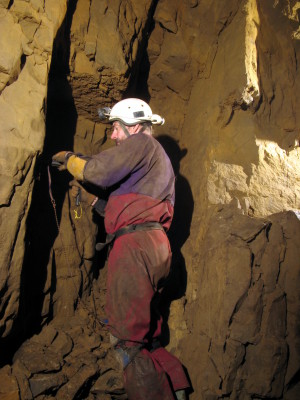
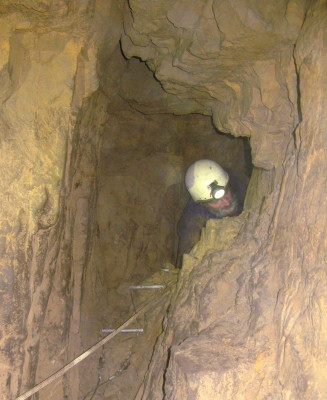
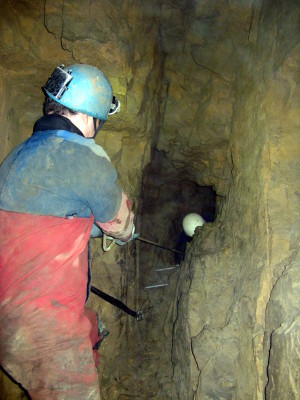
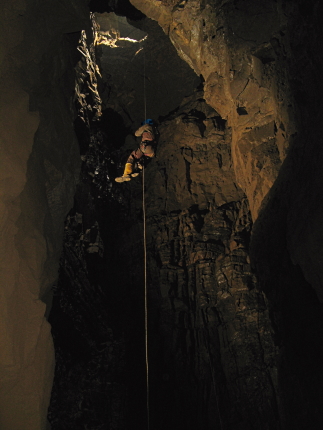
You must be logged in to post a comment.